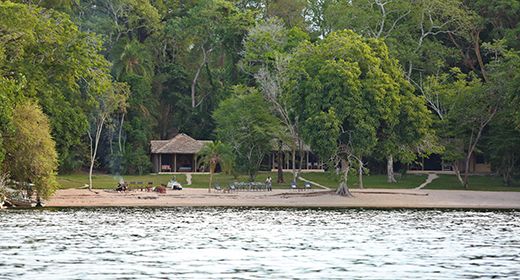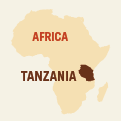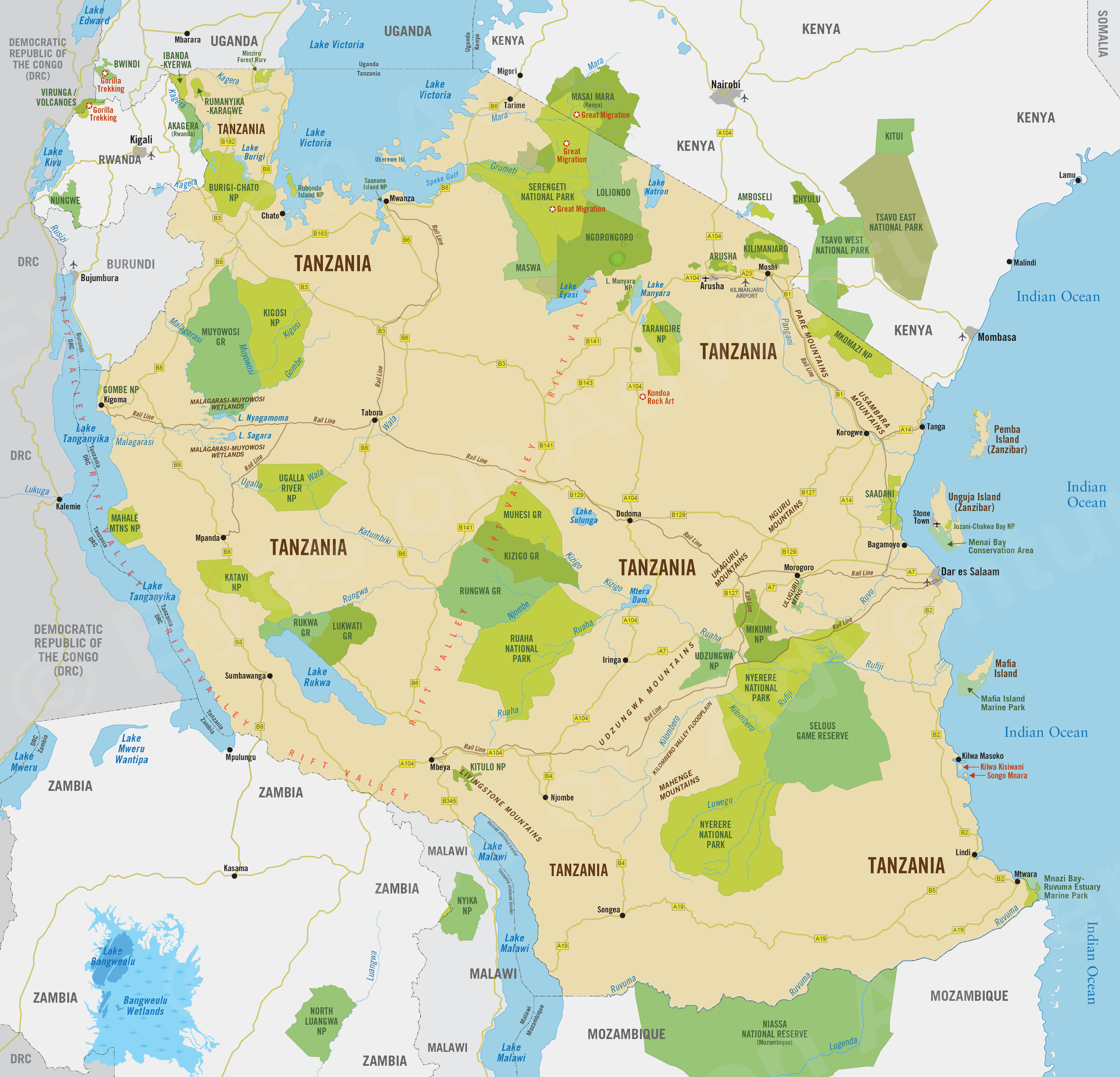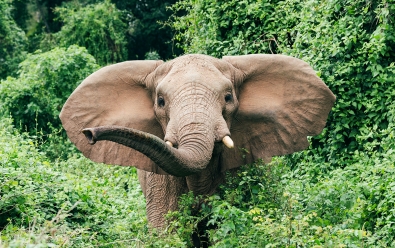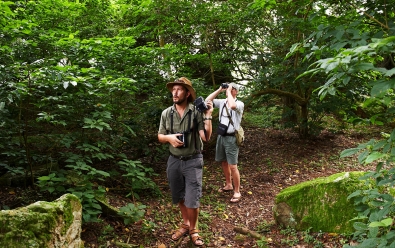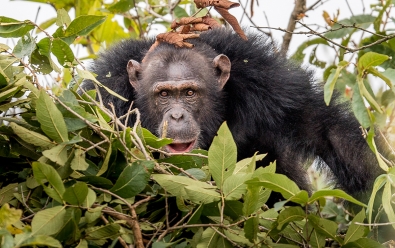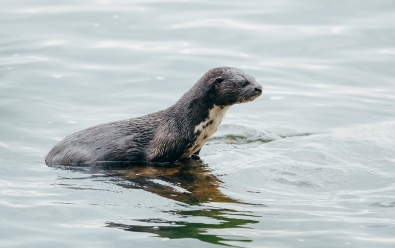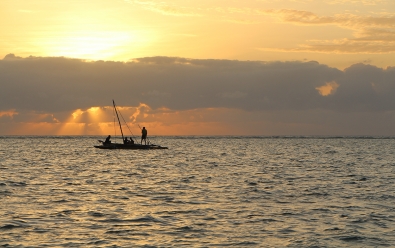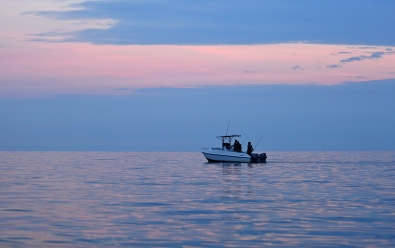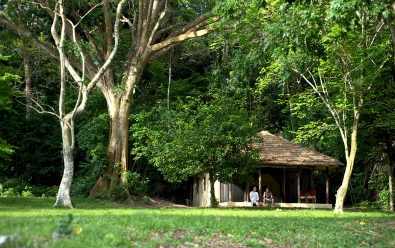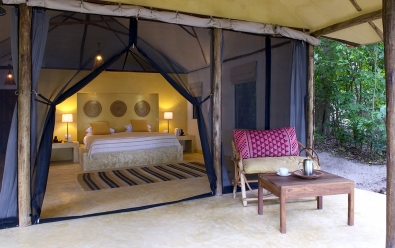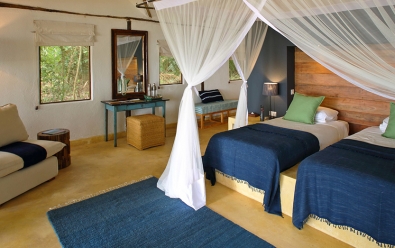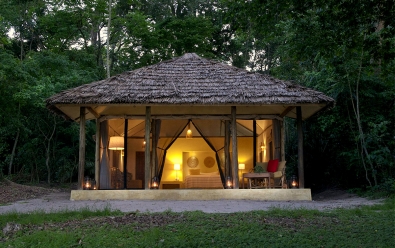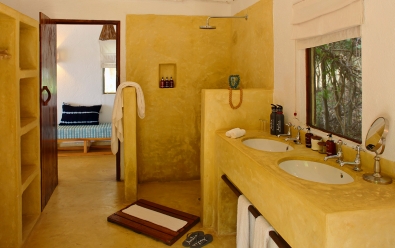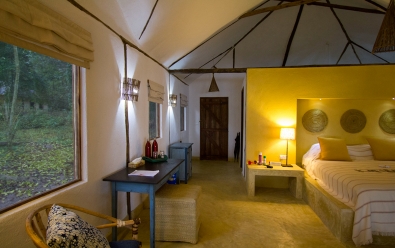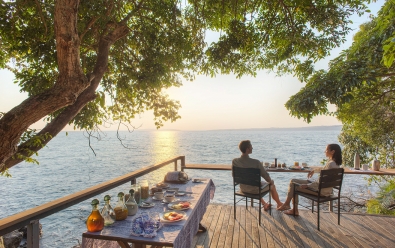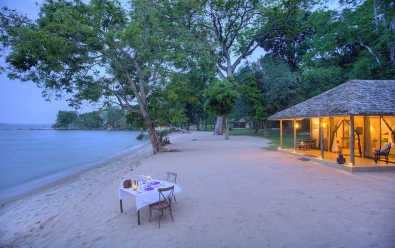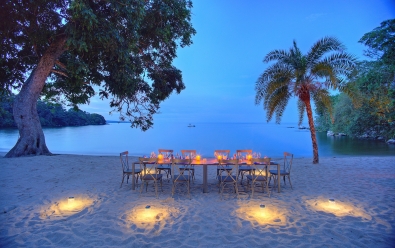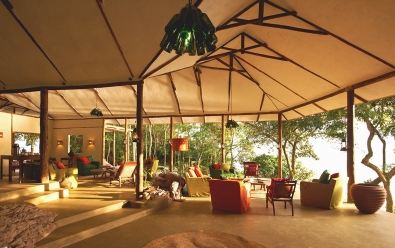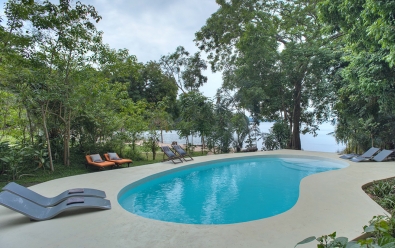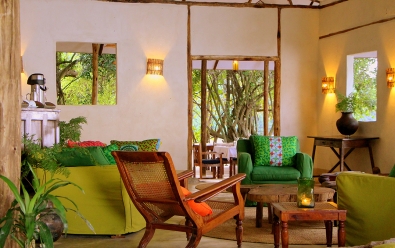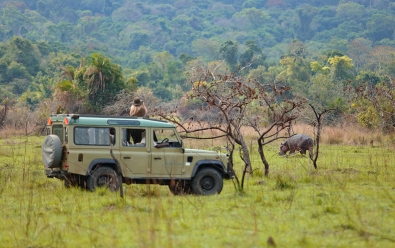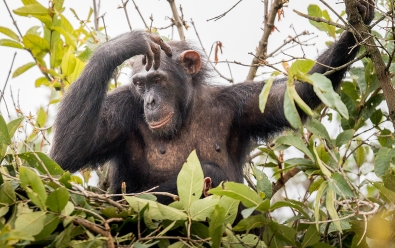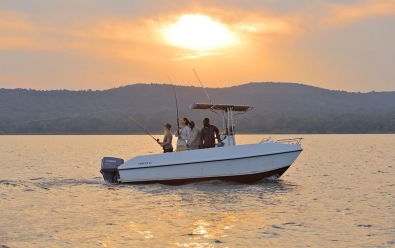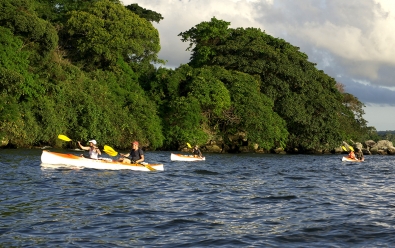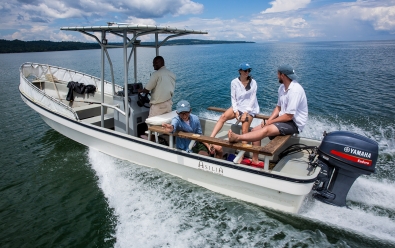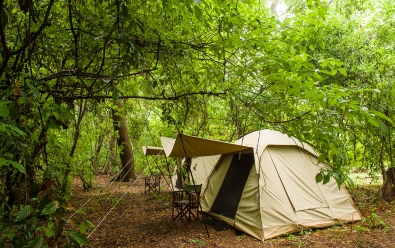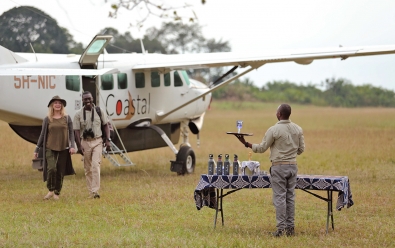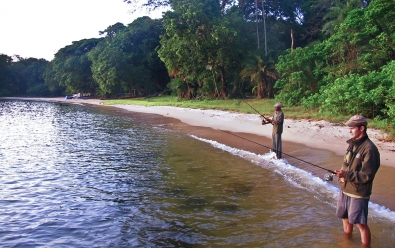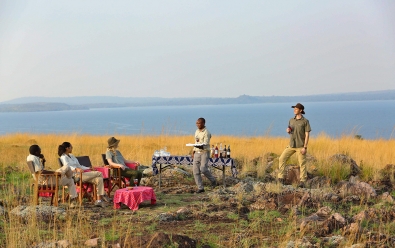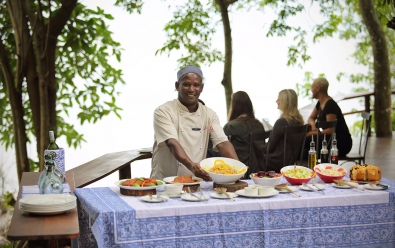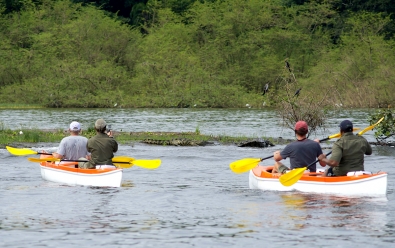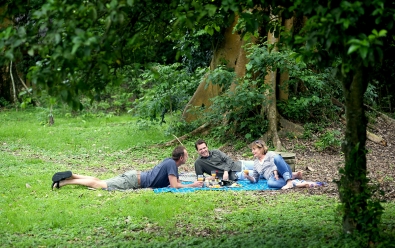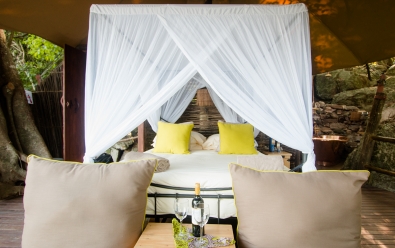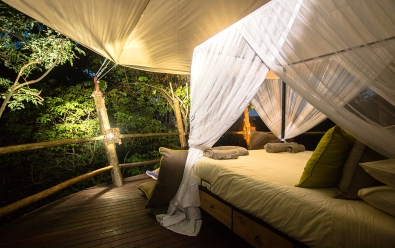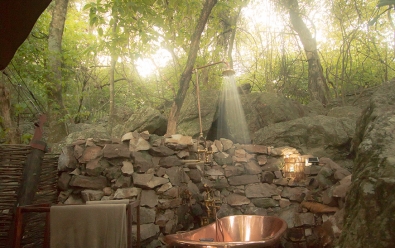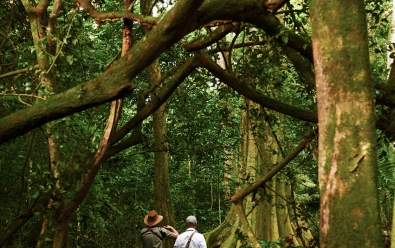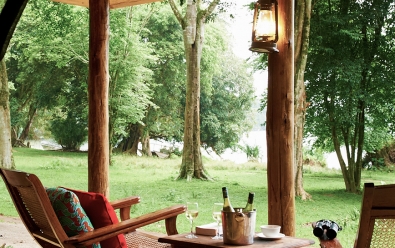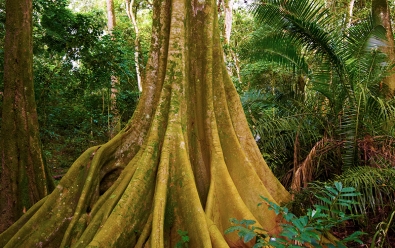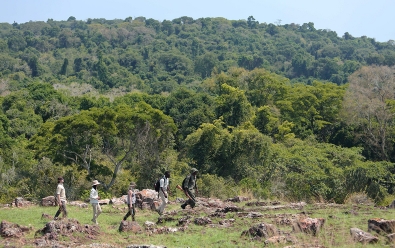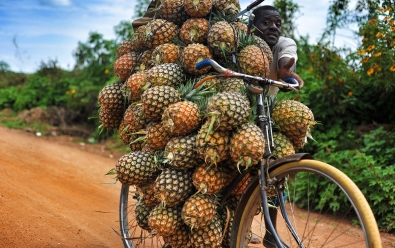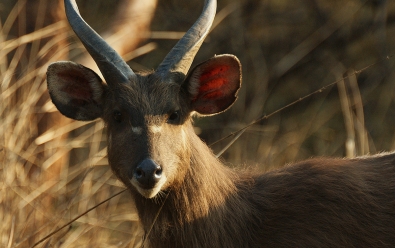Rubondo Island Camp
Highlights
- The only camp on the largest island-national park in Africa
- Chimpanzee trekking, fishing for Nile perch, kayaking, walking
- Easy to reach from Serengeti and other destinations in Tanzania
- Untouched forest with various primates and abundant bird life
Location
- Rubondo Island National Park
- Southwest Lake Victoria
- Northwest Tanzania
Rubondo Island Camp is the only accommodation on Africa's largest island-based national park, where guests can trek for wild chimpanzees, explore the lush forest, and fish for Nile perch on Lake Victoria.
Rubondo Island is located ion the far southwest extent of Lake Victoria, some 2 miles off the coast of the mainland. The island is uninhabited by humans other than the safari camp and is protected, along with substantial offshore lake habitat, as a national park.
Read more about Rubondo Island and its history below.
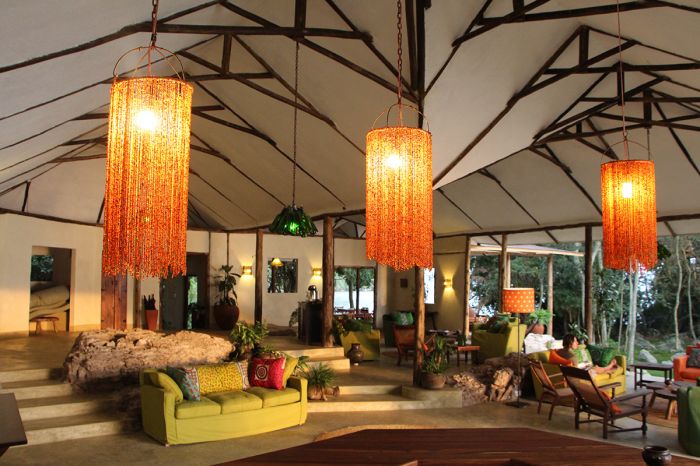
Main guest area at Rubondo Island Camp.
The island is home to chimpanzees, which were introduced from rescued chimps in the 1960's, but there are also giraffe, elephant, small, forest-dwelling antelopes, hippo, crocodile, other primates, and wonderful birdlife.
There are plenty of adventures to be experienced at Rubondo Island Camp, including game drives, walking safaris, chimpanzee trekking, boating, kayaking, and fishing on Lake Victoria, fly camping on the forest, and sleep outs in the treehouse. Visits to a local community on the mainland are also offered. Massages and other spa treatments are also available.
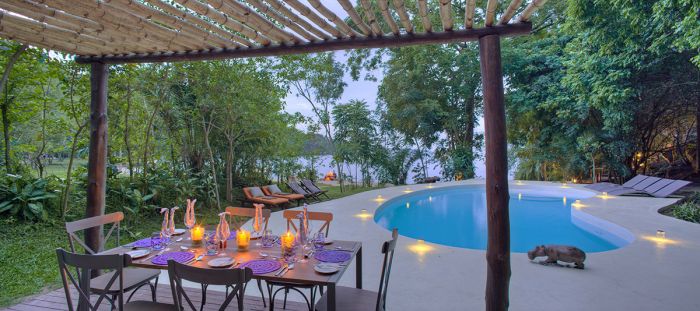
Main area swimming pool and view to Lake Victoria at Rubondo Island Camp.
The camp has 8 beachfront cottages, one of which is a two-bedroom unit designed for a family. The cottages are very comfortable and include plumbed, en-suite facilities with hot and cold water and flush toilets. The veranda in front of each tent offers superb views over the shoreline and eastward onto Lake Victoria.
Meals are often enjoyed al-fresco, either on the dining deck in front of the maim lodge or on the sandy beach. The main area includes a comfortable lounge, indoor dining space, a bar, and "The Nest", which is a library and information centre offering excellent materials about the island and its wildlife. The camp's relaxing swimming pool and sundeck are a lovely place to spend some time between activities.
The Rubondo Island experience is an excellent inclusion to add diversity to a Serengeti safari.
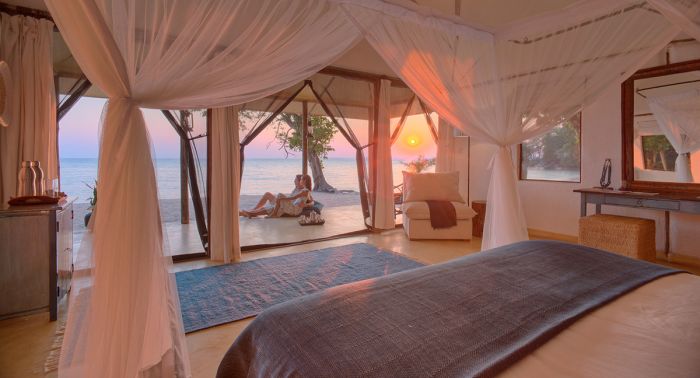
Guest cottage and view to Lake Victoria at Rubondo Island Camp.
About RUBONDO ISLAND
Rubondo Island is located in the far southwest of Lake Victoria, lying just over 2 miles (3.5 kms) offshore from the Tanzanian mainland at its closest point.
Established in 1965 as a game reserve, Rubondo Island (upgraded to a national park in 1977) is one of two Tanzanian island national parks in Lake Victoria (the other being Saanane NP). Covering the entirety of the main island of Rubondo in the extreme southwest corner of the lake, the park's boundaries also incorporate eleven minor rocky islets and surrounding offshore water.
In total, the park protects 176 square miles (457 sq kms), of which about half is land and the rest water. The main island measures 12.4 miles (28 kms) in length and is 2-6 miles (3-10 kms) wide. Rubondo Island and the surrounding islets are part of a partially submerged rift consisting of four volcanic hills linked by three flat sections.
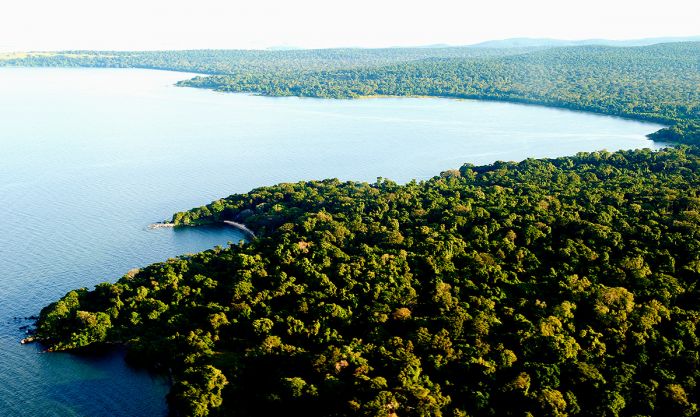
Aerial view of a portion of Rubondo Island. The camp's location is along the small beach near the small peninsula in the foreground.
The landscape on Rubondo is dominated by moist evergreen and semi-deciduous forest, much of which has dense understory. These forests covers around 80 percent of the island, with the remainder of the land interspersed with open grassland, Miombo woodland, and Acacia woodland.
Despite being volcanic in origin, there are granitic outcrops scattered across the main island. The eastern shore is characterized by sandy beaches and rocky areas, while the western shore is dominated by extensive papyrus swamp, bordered by date palms.
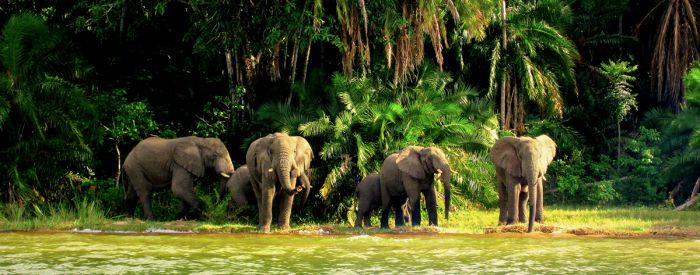
Elephants drinking from Lake Victoria on Rubondo Island.
Rubondo Island has an interesting history. The island had long been inhabited by a small community of indigenous people, who survived by fishing on the lake, but in 1965, the island was made an official game reserve, which meant the island's inhabitants, numbering around 400, had to relocate to the mainland.
In 1966, Bernhard Grzimek, a trained German veterinarian and Director of the Frankfort Zoological Garden (which he had saved from ruin after the end of World War II), visited Tanzania.
Grzimek, who was also President of the Frankfurt Zoological Society, convinced the Tanzanian government to allow him to introduce sixteen chimpanzees that had been rescued from zoos and circuses onto Rubondo Island, where they were allowed to live free in the wild. The adaptable chimps thrived and the island's population now numbers over forty.
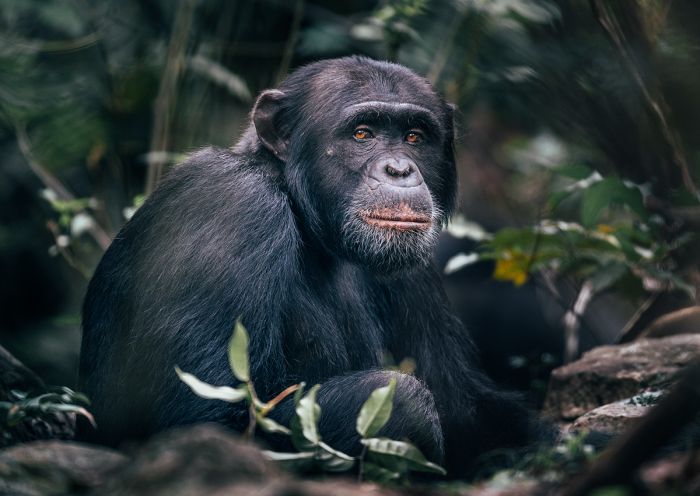
One of Rubondo Island's chimpanzees.
After the successful introduction of the captive-born chimpanzees, other species were introduced onto Rubondo, including elephant, black rhino, giraffe, roan antelope, black-and-white colobus, and the endangered suni antelope. The rhinos and roan didn't survive (due to poaching), but the other species are still present. In 2000, around 40 gray parrots that had been confiscated from illegal trade were released on Rubondo Island and they flourished and can be seen relatively easily.
Besides the introduced species discussed above, native wildlife that can be seen on Rubondo includes hippo, crocodile, civet, genet, spotted-necked otter, marsh mongoose, vervet monkey, bushbuck, bush pig, and sitatunga.
Birding on Rubondo is excellent, with over 400 species recorded. African fish-eagles are particularly abundant, and there are a variety of kingfishers, herons, storks, bee-eaters, raptors, and forest dwellers that will keep any avid birder busy each day on the island. Butterfly enthusiasts will love Rubondo and those interested in botany will enjoy seeing some of the over forty species of orchid that grow on the island.
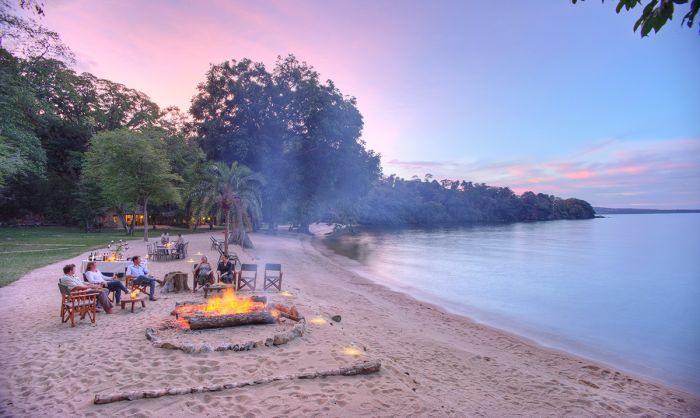
Enjoying evening drinks and discussion at Rubondo Island Camp.
Rubondo is one of Tanzania's best preserved wildlife destinations, but attracts only a small number of tourists. Rubondo Island Camp is the only accommodation and it offers an excellent experience.
The best time to visit Rubondo depends on your interest: the dry season (June-October) is best for clear skies and good weather, but the rainy months (November-December and March-May) are best for flowers, butterflies, and the abundance of birds, with many migrant species present and breeding.
The island can be accessed by charter flight direct to the island's airstrip or by boat from the mainland.
About Lake Victoria
Considered one of Africa's "Great Lakes" (along with Lake Tanganyika and Lake Malawi), Lake Victoria is situated between two arms of the East African Rift.
Lake Victoria is Africa's largest lake by surface area and the world's largest tropical lake. Victoria is also the world's second-largest fresh water lake (by surface area), covering 23 145 square miles (59 947 sq kms); only Lake Superior in North America is larger. Using volume of water as the measure, Lake Victoria is the ninth-largest lake in the world (not including dam-created reservoirs).
Lake Victoria has a maximum depth of 276 feet (80 meters) and an average depth of 130 feet (40 meters). Like Lakes Malawi and Tanganyika, Lake Victoria is home to a high diversity of fish, most which belong to the highly evolved Cichlidae family of bony fishes (known as cichlids). Cichlid fishes have been studied for decades and have provided many clues to evolution.
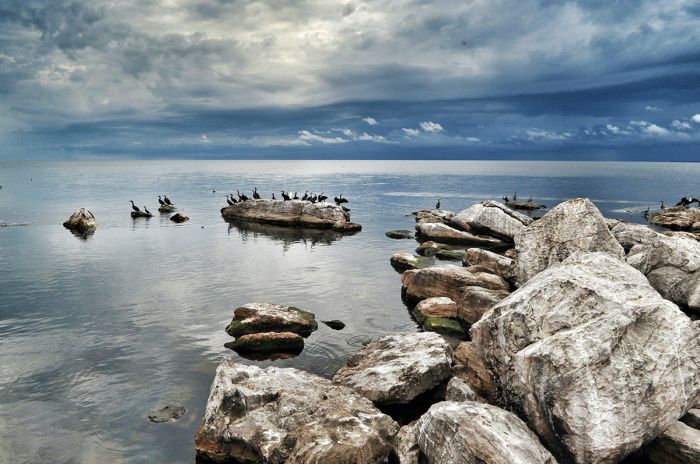
A small spit of rocks with cormorants on Lake Victoria.
Most of Lake Victoria's water (about 80%) is received by direct rainfall. The reminaing 20% of the lake's water comes in through rivers and numerous small streams. The most significant river contributing to Lake Victoria is the Kagera River, which flows into the lake on its western side. The Kagera River originates far to the south and has tributaries in Rwanda, Burundi, Uganda, and Tanzania.
The only outflow from Lake Victoria is the Victoria Nile River, which is also referred to as the White Nile. The Victoria Nile flows out of Lake Victoria on its northern side, close to the small town of Jinja (in Uganda).
Lake Victoria is shared by three countries: 45% is in Uganda, 49% is in Tanzania, and 6% is in Kenya.
The Nile Perch
The purposeful introduction of the highly predatory "Nile Perch" (Lates niloticus) into Lake Victoria in the 1950s is now viewed by ecologists as a very unfortunate human blunder. The Nile perch was introduced to Lake Victoria in hopes that they would multiply (they did) and create a source of protein and export revenue.
The plan did work, but sadly, as often happens when humans try to control nature, the result has been an ecological disaster that has resulted in the extinction of hundreds of native cichlid fish species, many of which were endemic to Lake Victoria.
The loss of hundreds of species of Lake Victoria fishes (almost all of which were cichlid fishes and most of those endemic species) notwithstanding, Lake Victoria is still home to more than 500 species of fish, which is the second-highest total (after Lake Malawi) for any lake in the world.
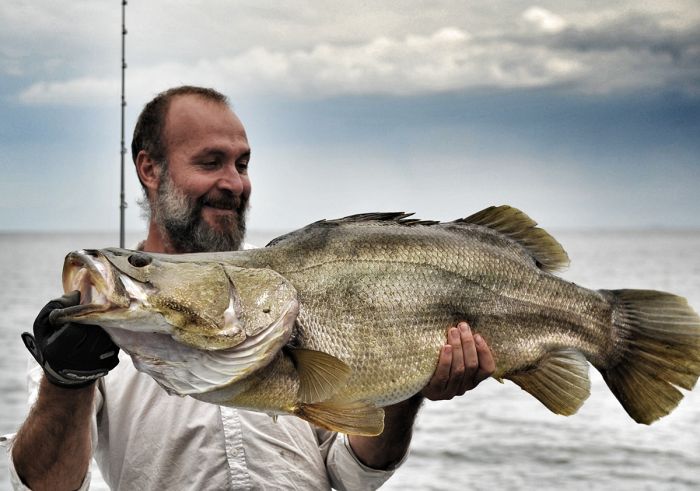
A nile perch (Lates niloticus) caught at Rubondo Island Camp.
ROOMS INCLUDES & EXCLUDES CHILDREN FACILITIES ACTIVITIES
Accommodation
8 guest accommodations in total comprising:
- 7 cottage, all of which can be set up with a double bed or two twin beds.
- 1 double / family cottage consisting of two bedrooms, one with a double bed (convertible to twins) and one with two single beds. The bedrooms share the en-suite facilities.
The cottages are made from local wood and stucco, with high-pitched ceilings and thatched roofing atop slightly elevated concrete slabs. Every cottage includes en-suite facilities with plumbed hot and cold water, a double-basin vanity, indoor shower, and flush toilet. The cottages are accessed via footpaths on the ground leading to the main lodge area.
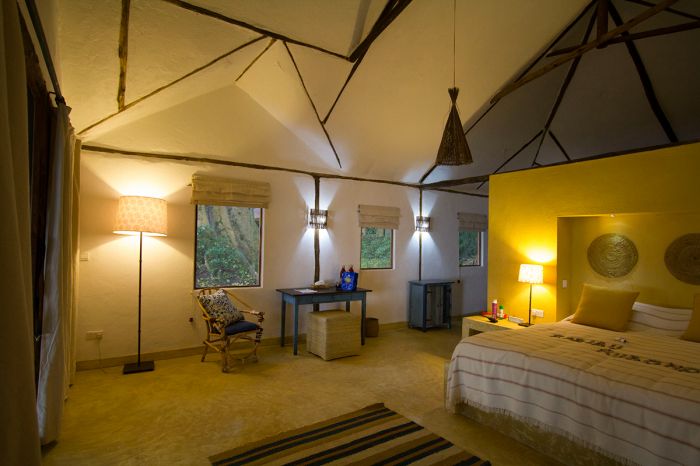
Guest cottage interior at Rubondo Island Camp.
The main lodge area and guest cottages are set back at the edge of the forest and sand beach on the eastern side of the island, overlooking Lake Victoria.
Each cottage has a covered outdoor veranda with seating offering excellent views of the lake.
Other items and features in the guest tents include:
- Writing desk and chair.
- Indoor lounge chair.
- Clothes storage dresser.
- Mosquito netting over the beds.
- Safe.
- 24-hour power (provided using a combination of solar and generator) for lighting and charging electronics.
- Hairdryers are not supported by the solar / generator power system.
- WiFi available in the guest tents and main guest areas.
- Mobile phone signal available, but limited.
Rubondo Island Camp can accommodate a maximum of 18 guests in total: 2 persons in each of the 7 standard cottages and 4 persons in the family cottage.
Includes & Excludes
Includes:
- All meals and house drinks, including wines, local brand spirits and beers, teas, and coffees.
- Safari experiences (forest drives, swamp excursions, walking, chimpanzee habituation experience, fishing, and birding) accompanied by an experienced guide.
- Fly camping in the forest.
- Sundowner drinks and snacks.
- Laundry services are provided on a daily basis (weather permitting, items will be returned on the same day). Laundry is dried by the sun and on most days any laundry placed out in the morning will be returned by the evening.
- Wi-Fi access (throughout the entire camp).
- Rubondo Airstrip transfers.
- Tourism Levy & VAT.
Excludes:
- Champagne, cognacs, fine wines, premium brand spirits, and cigars.
- Exclusive fishing boat hire.
- Chimpanzee trekking permits.
- Spa treatments.
- Purchases from the Gift Shop.
- Any applicable wildlife fee, park fee, reserve fee, concession fee, other land-use fee.
Single Supplement
A single supplement may apply for any room booked by a single traveler; please ask us for pricing.
Children
Children aged 5 years and older are accommodated at Rubondo Island Camp:
- 1 family cottage sleeping two children.
- Ask us about reduced rates for children sharing with adults or children 12-17 in their own cottage.
- Children's menu available.
- Children under 5 years are allowed only if the camp is booked exclusively.
Activities with children:
- Minimum age for walking and fly-camping is 16 years.
Facilities
The main guest area and cottages are located at the edge of the forest along the beach, overlooking the eastern shore of the island.
The main guest area consists of a combined lounge, bar, and dining space constructed using local timber and stucco atop a slightly raised cement base. The structure has high-pitched ceilings, thatched roofing, and is open on the front side facing the lake.
Main guest area facilities include:
- A combined dining, lounge, and bar space with a wooden deck overlooking the water.
- "The Nest" library and information centre for resources about the island and its wildlife.
- The viewing deck is also used for dining, which are taken al-fresco, weather permitting.
- Dining is typically communal, but private dining is available on request.
- Swimming pool and sun deck overlooking the lake.
- Campfire area on the beach.
- Elevated birding hide overlooking the lake.
- Gift Shop.
- Treehouse located nearby for sleep-out; includes a comfortable bed and plumbed facilities.
- Spa treatments offered in guest cottage or on the beach.
- Complimentary Wi-Fi access.
- Mineral water is provided in the main camp areas and in the guest tents.
- The camp is powered by a combination of solar and generator.
Activities
Activities included in the rate:
- Morning and afternoon game drives in semi-open 4x4 vehicles.
- Chimpanzee trekking (chimp permits are not included).
- Nature walks with a trained and armed guide.
- Boating and kayaking on Lake Victoria.
- Fly camping in the forest.
- Treehouse sleepout (includes a comfortable bed and plumbed facilities).
- Fishing (catch and release) on Lake Victoria.
- Bush meals and sundowners.
- Birding.
- The game drive vehicle is fitted with inverters for battery charging on game drives.
Optional activities at additional cost:
- Private fishing boat hire.
- Guided visit to a local community on the mainland.
- Spa treatments.
Example of a typical day:
- Early morning wake-up call. Morning wake-up and activity times vary according to the seasons, activities on offer, and wildlife sightings.
- Light breakfast before departing on the morning activity or food packed for an earlier departure.
- Return to the camp for a meal and rest period (full-day outings mean lunch is packed).
- Meet for afternoon tea and snacks (savory and sweet choices) before departing on the activity.
- Return to camp - freshen up or meet for drinks, followed by dinner.
- Enjoy a nightcap and/or discussion at the bar or around the campfire before retiring.
Great Good Fair Poor
- Jan
- Feb
- Mar
- Apr
- May
- Jun
- Jul
- Aug
- Sep
- Oct
- Nov
- Dec
GENERAL TIPS
Like all of northern Tanzania, Lake Victoria experiences its heavy rains during March and April, so it is best not to visit during this time. June to mid-October is mostly dry and this is an optimal time to visit.
Forest drives and walks are much easier outside of the rainy seasons and there are fewer mosquitos at this time as well. Temperatures are cooler during the dry season, although it is generally pleasant all year.
The region experiences most of its rain between November and May, but there are two somewhat distinct rain seasons, the 'short' rains and the 'long' rains (read more below).
Rubondo Island Camp is closed from 01 April thru 31 May.
RAINS
Short Rains
The short rains occur for about one month sometime during November and December (the exact time varied somewhat year to year). This period is called the 'short' rains because the duration of an individual rain event is short and it is rare to have an all-day rain event. Most rain falls as an afternoon shower, while mornings are typically overcast or clear.
By late November, the landscape is lush, migrant birds have arrived in huge numbers, and flowers are in bloom, including over 40 species of orchid. For birders, the best time to visit is between December and March, when the migrant birds arrive in great number.
Long Rains
The long rains occur between March and May, with April being the wettest month of the year. During this tome, rain should be expected almost every day and the showers can last for hours at a time, although all-day rain is not typical. The roads on the island are frequently muddy and very difficult to traverse in places, which can hamper forest drives. Cloudy skies are typical and temperatures can be chilly at times.
The period between the short and long rains (January and February) also receives rain, but many days are clear and the amount and duration of the rain events is unpredictable, with some afternoon showers and the odd long and heavy rainfall event.
TEMPERATURES
The temperatures on Rubondo Island are fairly consistent throughout the year, as the island lies only two degrees south of the equator.
In general, daytime temperatures are comfortably warm and overnights and early mornings are only moderately cool. Daytime temperature range from 77-90°F (25-32°C), while the overnight range is 59-68°F (15-20°C). Bring a fleece and rain jacket regardless of the timing of your visit.
Dry Season
The dry season (June to October) experiences daily sunshine and warm temperatures. Rare rain showers can occur but are unlikely. From June thru August, the afternoon high temperature averages 80-84°F (26-29°C), but some days can be warmer. Evenings and early mornings temperatures are pleasant to slightly chilly, averaging 59-63°F (15-17°C).
September and October days are very pleasant. With a warming trend as the days progress. Daytime high temperatures average 82-87°F (28-31°C), with comfortable mornings persisting, averaging 62-66°F (16-19°C).
Rainy Season
The rain season is November through May (read more above) and the temperatures are fairly static throughout the season. Daytime temperatures average 83-88°F (28-31°C) and nighttime and early morning temperatures average 63-67°F (19-20°C).
Chimpanzee Trekking
Dry Season (June thru October)
The best time to visit Rubondo Island for the chimpanzee habituation experience is from June thru October, which coincides with the dry season. Trails in the forest are dry, making walking easier.
The chimps tend to range less during the dry season due to an abundance of ripe fruit, which is abundant during this time. Fruiting trees provide around 80 percent of the chimpanzee diet, and the proliferation of this food source during the dry months means that the chimps remain in a location to feed, making it easier to find and observe them.
Beginning in mid-September, very early rains can occur and the availability of ripe fruits is waning, which causes the chimps to move around on the island in search of food. During October, the chimps will remain in an area with fruit for a day or two, before moving again to look for food.
Rain Season (November thru May)
The 'short' rains occur during November and December and water runoff can impact chimp trekking activities. Walking trails in the forest become muddy and slippery after a rain shower, making walking more challenging. Chimps are a challenge to locate and finding them can be hit or miss.
From the end of December and into January, the chimpanzees move away from the center of the island toward the north edge of the island. The short rains are finishing toward the end of January.
Starting in late January, the chimpanzees move randomly in search of food, making it a challenge to locate them. Chimpanzee are renowned for not sitting still, so come prepared with a spirit of adventure and a good level of fitness.
Once the 'long' rains begin sometime during March, chimp trekking becomes very challenging and even if found, the chimps are usually silent and motionless during a heavy shower.
The camp is closed during all of April and May.




